Left: Aerial View [Google Maps] of Augusta Bagiennorum with Cardo and Decumanus; Right: View of Farmhouse and Wheatfield near Augusta Bagiennorum
Left: View of Theater and Hospitalia at Augusta Bagiennorum with Monviso (Monte Viso) in the Background; Right: View of Uncovered Part of Forum
Last May 2013, we spent an early morning at Augusta Bagiennorum in Piedmont, near Bene Vagienna, Cuneo. We were staying a few weeks in the region (see Two Weeks in Villanova Mondovi - Off the Piemonte Tourist Track) and ventured out for early morning forays as we waited for the rest of our party to assemble.
Augusta Bagiennorum is a site that was an old Roman town dating to the last quarter of the first century BC (according to the sign at the site), probably at the same time as Augusta Taurinorum (Torino) and Augusta Praetoria (Aosta). Only a few tantalizing bits of Augusta Bagiennorum are visible in the surrounding farm land on the site. Today, the site is part of a reserve, Riserva Naturale Augusta Bagiennorum.
According to a sign at the site, the first inhabitants were probably veterans of Augustus and the town is named for him. Before the Romans, the area was occupied by the Bagienni, an ancient Ligurian people that lived in what today is southwest Piedmont. The Bagienni lend their name to the modern-day commune of Bene Vagienna. The Bagienni were conquered by the Romans around the middle of the 3rd century BCE, becoming part of the Roman Republic.
The layout of the town follows the standard Roman city grid. The decumanus maximus (the main east – west oriented street) actually runs southwest to northeast here. The cardo (the main north – south oriented street) runs southeast to northwest.
Views at and from Augusta Bagiennorum, View toward Podi and Monviso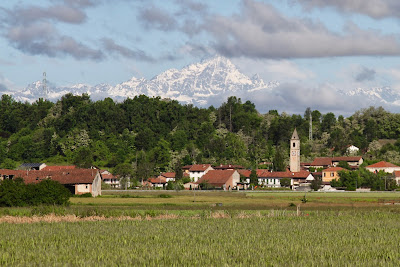
The site was discovered by Giuseppe Assandria and Giovanni Vacchetta. Assandria was born in Bene Vagienna, and Vacchetta in Cuneo. The comune site has a summary of their lives and how they found Augusta Bagiennorum – of which a piece is shown below:
All'inizio del secolo i due storici benesi si dedicarono con successo alla ricerca dell'Augusta tante volte citata dagli scrittori latini. Gli studi sul territorio vennero condotti tra il 1892 ed il 1908 con tecniche archeologiche ormai largamente superate. I due, disponendo di ingenti somme di denaro, poterono pagare di tasca propria dei braccianti, arruolati prevalentemente nella zona del Podio e della Roncaglia, per scavare su quelle terre che intuitivamente si credettero custodire i resti della romanità. Le perlustrazioni del sottosuolo venivano effettuate nei periodi di incolto, quando non si arrecavano danni alle colture. Gli appezzamenti venivano infatti affittati in autunno, scavati nei mesi a seguire e nuovamente spianati in primavera e restituiti ai proprietari per la nuova annata agricola.
Feeble translation: At the beginning of the century, the two prosperous historians devoted themselves to looking for Augusta, a site cited many times by Latin writers. Their studies were carried out between 1892 and 1908 with archaeological methods of the day. The two, with their own large personal wealth, could pay for laborers, recruited from the area of Podio and Roncaglia, to excavate where they [Assandria and Vacchetta] intuitively believed the remains of the Roman site were located. The subsurface explorations were carried out in times of fallow, when they would not be causing damage to the crops. The plots were, in fact, rented out in Autumn, excavated in the following months, and leveled again in Spring to return the property to the owners for a new crop.
The most visible parts of Augusta Bagiennorum are the amphitheater (l’anfiteatro) and the theater (il teatro). The foundation of approximately one half of the amphitheater is visible and atop it sits Cascina Ellena – a bed and breakfast. At the theater enough is uncovered and reconstructed to get a sense of the size of it and how it might have felt have watched a performance there. The theatre has two reconstructed doorways are called hospitalia – the passages for the actors to access the stage.
A few years ago, we wrote about the proportions of Vitruvian Man, a study of symmetry of the human body by Marcus Vitruvius Pollio. Vitruvius, in his book De Architectura, also talked about the design of theaters (Book V/Chapter VI) which likely is the design for this theater.
On this day in late in May when were there, nobody else was there. Granted it was early in the morning (before 9 am). Entrance is free and parking is marked on the map included with this post. Augusta Bagiennorum is one of the few Roman ruins in Piedmont that are out in the open like this. We did not make it to the Museo Archea (it was closed and we didn’t have enough people for a private group) – archeologia didattica e sperimentale located a stone’s throw from the ruins in Podio or the Museo Archeologico di Bene Vagienna in the Lucerna Palace of Rorà in nearby Bene Vagienna.
Left: La Cappella San Pietro at Augusta Bagiennorum; Right: View of Podi
Left: Augusta Bagiennorum - Ruins of la basilica cristiana; Right: Cascina Ellena and Ruins of Amphitheater
The Theater (il teatro) at Augusta Bagiennorum with Schematic from Vitruvius Book V – Chapter VI of De Architectura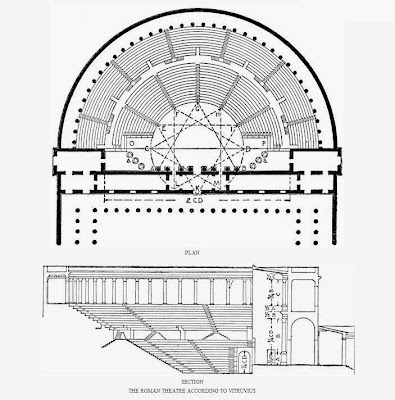


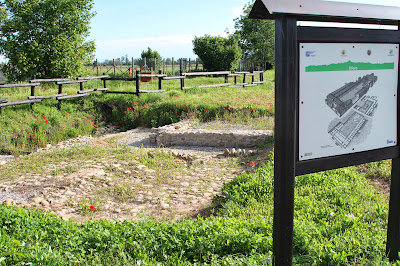







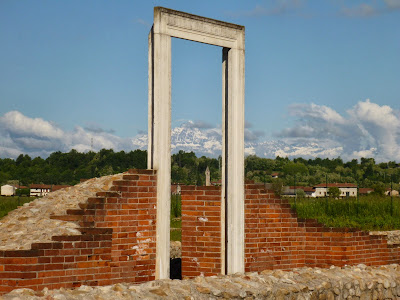


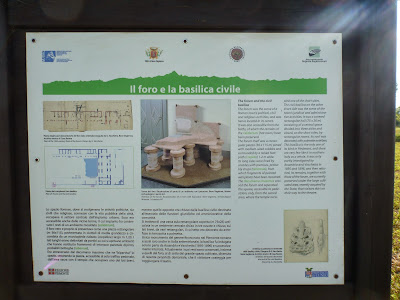


.JPG)






No comments:
Post a Comment
All comments are moderated. If your comment doesn't appear right away, it was likely accepted. Check back in a day if you asked a question.